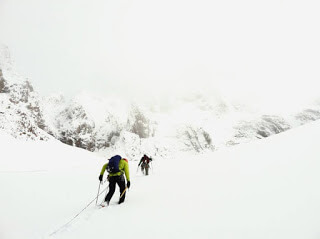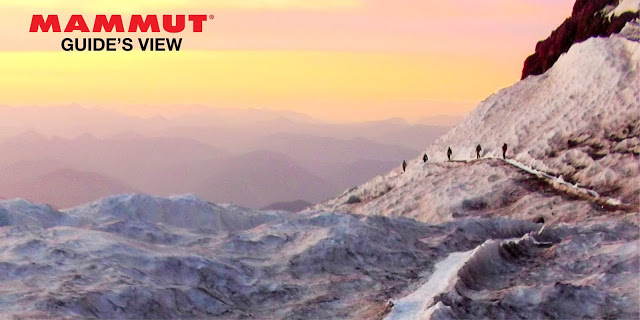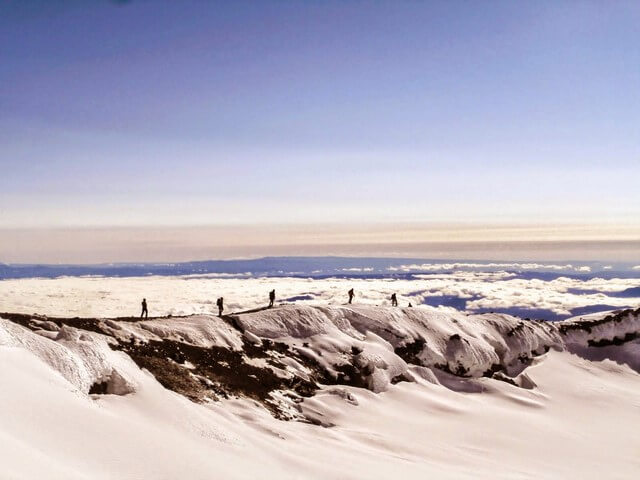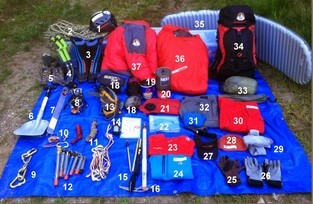
|
| Located in the most popular alpine arena in the North Cascades--Boston Basin--the Quien Sabe Glacier is rapidly diminishing. |
Showing posts with label Kel Rossiter. Show all posts
Showing posts with label Kel Rossiter. Show all posts
Monday, March 5, 2018
Guides for Glaciers: Mountain Guides and Mountain Enthusiasts on the Front Lines of Climate Change
Friday, December 22, 2017
Reflections in the Ice
|
|
| Gazing into the lens of past ice seasons and considering what is in store. Photo credit: Alysse Anton |
Last year was likely the best season
of my ice life. I enjoyed such a stellar season, both in terms of
guiding and in terms of personal climbing that it prompts me to lean
back, shake out, and ponder why—after all, it's much less the
climbing that I seek in the ice, than the lens on life that this
translucent and ephemeral substance provides me. So, taking my tools
out of the closet and strapping on crampons for this season's ice,
it'd be wise to reflect upon why. After all, the mind is a muscle—as
vital to effective ice climbing as calves and triceps. So, as the
leaves wither and we await first ice, as I do my lock-offs, calf
raises, and tricep extensions to prepare my body for another season
of ice, it's also wise to pay heed to the brain that this body
carries around. Reflecting on last season, here's a couple of
concepts that highlight the learning that stretched my brain muscle
last season:
Saturday, September 10, 2016
Essential Glacier & Crevasse Terrain Travel Strategies

|
| It's the beauty of glaciers that bring us there--but we need
strategies for doing so safely.
(Mt. Rainier)
|
Glacier Travel and Crevasse Terrain
Glaciers are a magical part of the alpine landscape—their massive icy hulks, laid down over the eons, are reminders of power of persistence and their diminishing modern state serves as a reminder of our precarious position as stewards of the Earth. Traveling over glaciers, experiencing the crevassing, tumbling, tumultuous, patterns is to experience the passage of time directly. But it is precisely because of this crevassing, tumbling, and tumult that your glacier travels skills need to be sharp before integrating glaciers into your alpine climbing quiver.
Tuesday, June 30, 2015
Keeping the Learning Edges Sharp
|
|
| Scenes from the San Juan Mountains, site of the AMGA Ski Guide Course. |
Heading to Ouray without ice tools in
my bag stung like sharp shards coming off a misplaced swing on a
bulletproof day. The wealth of ice climbing opportunities that this
area of Colorado's North San Juan Mountain Range offers is
well-known. Less well known—and as I would soon discover—is that
the ski mountaineering options offered in the North San Juans is on
par with the ice. I was headed out to explore those options, by way
of the American Mountain Guides Association (AMGA) Ski Guide Course
(SGC). Having completed both the Alpine and Rock Guide certification
programs a few years ago, I was interested in exploring the Ski Guide
program with a eye toward International Federation of Mountain Guides
Associations (IFMGA) certification (you must complete all three
tracks for IFMGA certification), but approached it with a keener
focus on keeping my learning edges sharp.
Wednesday, November 26, 2014
50 Miles of Wilderness for 50 Years of Wilderness

|
| There are things that humans can't improve. |
Wilderness has always been a contested term. The word offers an expanse of subjectivity in which to insert interpretation and to project meaning. In 1964, wilderness was given an official political definition with the passage of the Wilderness Act. Congressional acts aren't often noted for their eloquence, so The Wilderness Act of 1964 is all the more exceptional in its lyrical designation of wilderness as:
"A wilderness, in contrast with those areas where man and his own works dominate the landscape, is hereby recognized as an area where the earth and its community of life are untrammeled by man, where man himself is a visitor who does not remain."
With that act, Congress settled itself upon a term for what wilderness was and set about designating certain areas of federal lands—national parks, forests, and otherwise—as “Wilderness Areas.”
Tuesday, August 26, 2014
What is Above Knows What is Below--A Reflection on the Rainier Season

|
| Climbers on Rainier's crater rim. |
Friday, August 8, 2014
A Packing Gear and Equipment List for the North Ridge of Mount Baker
Climbing the North Ridge of Mount Baker
is a unique summertime alpine objective: with the exception of a few
ice couloirs in Sierras, it's pretty hard to find true blue ice
climbing smack dab in the middle of the dog days of summer—but the
North Ridge offers just that. Depending on how you handle the
pitching out of your climbing, the time of year, and the particular
route conditions, there are typically 3-4 pitches of enjoyable ice in
the W12-WI3 range (and head further to climbers' right if you want to
bump it into WI4), and a seemingly endless series of low-angle calf
burner pitches to boot.
Thursday, July 4, 2013
Testing Out the Mammut Sphere Sleeping Bag and Light Pump Mat on Rainier's Wilder Side
It seems that the "blue bubble" may have finally arrived in Washington. After a largely damp and gray May and June, we hit a blue streak last week. Under clear skies I headed out with a team to explore "Rainier's Wilder Side"--the Emmons Route. By the numbers, about 70% of Rainier aspirants climb via the Muir/DC Route, 20% climb via the Emmons Route, and 10% climb via other routes. So Rainier's Emmons Route tends to be a quieter, wilder way up the mountain.
A few of the reasons that the Emmons Route is quieter than the Muir/DC Route are:
|
|
At ~13,800', nearing the summit via the Emmons Route.
A few of the reasons that the Emmons Route is quieter than the Muir/DC Route are:
Wednesday, June 26, 2013
The Mount Rainier Summer Summit Season Begins (Sort Of!)
After a springtime
of climbing and guiding in Alaska/Denali and an enjoyable stint back
in Mammut & my home-base state of Vermont, I arrived back in the
Pacific Northwest this past week for a series of Rainier climbs with
Rainier Mountaineering Incorporated (RMI). As chance would have it,
my climb was slotted to be the first climb of the summer
season—apparently though, nobody had shouted to the sky that it was
about to be summer. Or, if they had, the sky wasn't listening.
|
|
| Practicing self-arrests during the training. |
Wednesday, April 24, 2013
Packing the Heron Pro for Alaska/Denali-McKinley
Got out my Heron Pro and put together
my pack for Denali today: 3 ropes, 2 full racks, 8 liters of water,
and ankle weights. Sound to you like a savvy packing list for
heading out onto the Kahiltna Glacier for a month? Me neither. But
of course, packing for Denali begins long before the climb, with
plenty of training and prep beforehand. This season I'll be guiding
both Rainier Mountaineering Incorporated's (RMI) first-ever AlaskanAlpine Seminar and a Denali/McKinley Climb, so I'll have both heavy
and light packs on for over a month on the cliffs, couloirs, and
glaciers around this proud mountain. And while the ice season with
Adventure Spirit Rock+Ice+Alpine provided plenty of training for
those steep couloirs, I do need to stretch the legs, fill the lungs,
and condition the back a bit for Denali's notoriously beastly loads.
Having recently joined the Mammut team,
I'm looking forward to testing and reporting back on how the Heron
Pro goes at carrying those beastly loads. Even in the training
phase, as I try to fill it up with everything, the kitchen sink, and
the stove, I'm impressed by its seemingly insatiable maw. I'm also
liking the rotational carriage system on the waist-belt, tempering
sheer brawn with some degree of elegance in movement. I'll be out on
the glacier until early June, but I'm looking forward to delivering a
full report when I'm back down. In the meantime, wishing everyone a
strong start to the climbing season!
|
|
| Hauling the Heron Pro in Vermont's Green Mountains |
Labels:
Alaska,
Denali,
Heron Pro,
Kel Rossiter,
Mount McKinley
Subscribe to:
Posts (Atom)

